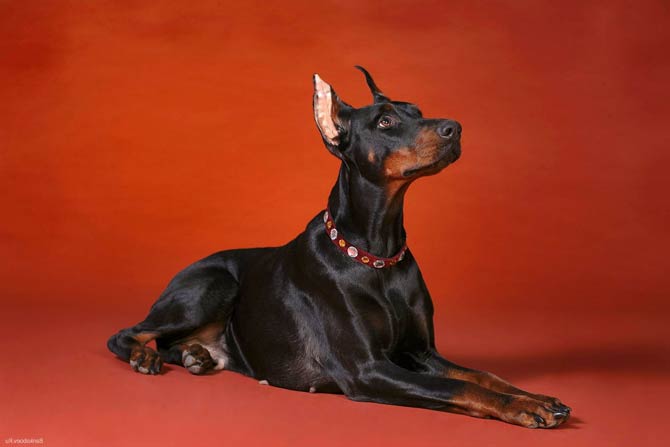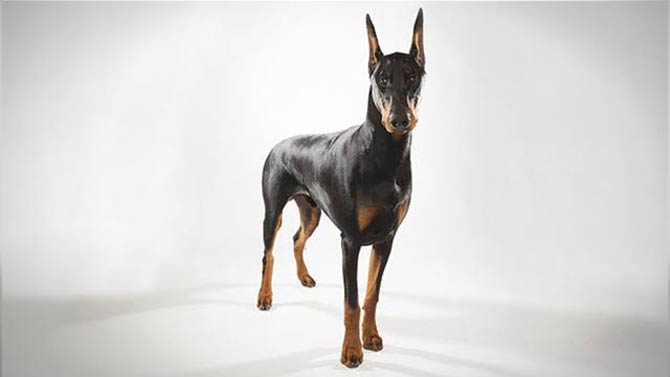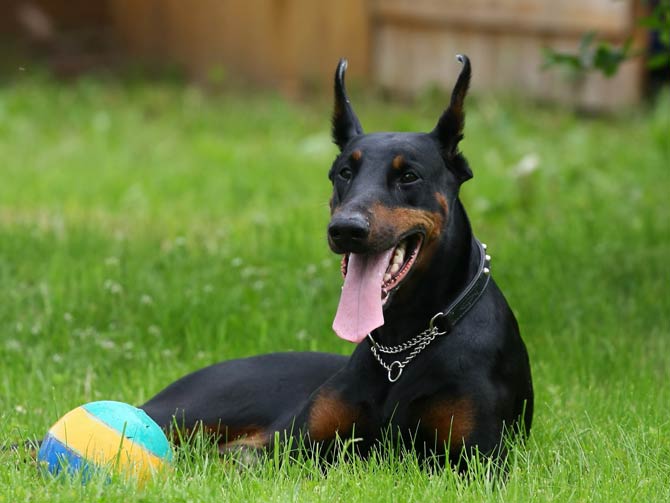Dog breeds – Dobermann
A dog of noble appearance and dignified behavior, being at the same time an effective “bodyguard” of its owner. The Doberman was named by its first known breeder – Friedrich Louis Dobermann. Thanks to his intelligence and temperament, he is suitable for many dog sports , such as B. Agility, Obedience, VPG-Sport, or as a tracking dog. But it is also used as a service dog by the police, customs and the armed forces and as a rescue dog. The Doberman is also suitable as a therapy dog and guide dog. In many movies, it is portrayed as a fierce defender with an aggressive nature who will not hesitate to attack the attacker. How much truth is there in the above images? Let’s try to find out.
FCI classification
- Group 2 Pinscher and Schnauzer, Molossian type Dogs and Swiss Mountain and Cattle Dogs
- Section 1 Pinscher and Schnauzer
- With working trial
- Origin: Germany
- Common nicknames: Dobie, Doberman

History of the breed
Doberman pinschers were bred from around 1890 in Apolda – a German district town located in the federal state of Thuringia. The breeding was undertaken by Karl Friedrich Louis Dobermann after the Franco-Prussian War. This man was, perhaps, a tax collector and dogcatcher, who sought to create a breed of dogs that would be perfect for protecting against dangerous people while carrying out his official duties.
He wanted the new type of dog to become a combination of strength, speed, endurance, intelligence, loyalty and ferocity. After the Dobermann, Otto Goeller and Philips Greunig tried to implement the plan, developing a breed that we can observe today.
The breed is believed to have been created from many different breeds with the traits that were sought for in Dobermans. Therefore, the French Shepherd Beauceron, Great Dane, Greyhound, Rottweiler, Weimaraner Shorthaired Pointer, German Shorthaired Pointer, Manchester Terrier, German Shepherd Dog, Middle Pinscher and Thuringian Sylvan Dog contributed to the creation of the breed.

To this day, however, the genetic proportions of all breeds that were crossed with each other have not been known. Many experts believe that the Doberman is a combination of at least 4 of the previously mentioned breeds. An exception is the documented cross between Greyhounds and Manchester terriers, and it is also believed that the largest gene pool of modern Dobermans comes from the German Longhair Shepherd.
After Dobermann’s death in 1894, the Germans named the breed Doberman Pinscher in honor of the originator of the breed, but half a century later the term “pinscher” was deleted because it was decided that the German word for terriers was not appropriate. A few years later, the British made a similar assumption. During World War II, the Marines (United States Marine Corps) engaged Dobermans in hostilities, but not only this corps appreciated their skills.
In the post-war times, Dobermans’ merits were slowly forgotten, which almost led to the extinction of the breed. One of the saviors was Werner Jung, who resurrected the dogs on his own, looking for German farms where he could meet pinscher, then crossing them with 4 miniature pinschers and a black and red bitch from eastern Germany. He risked his life to smuggle her into West Germany. Thanks to this bold act, most of the modern German Doberman pinschers are descendants of the aforementioned female and 4 males.

Characteristic
Appearance
The breed standards describe the Doberman as a medium-sized dog with a short coat of hair. Compact and slender figure, typically sporty, the dog itself should seem proud, alert, balanced and obedient, because the breed’s primary purpose was to be a guard. Dogs are muscular but noble, while bitches are more delicate than males.
Size
Dogs are usually 68 – 72 cm (27 – 28 in) high at the withers, females 63 – 68 cm (25 0 27 in), while the silhouette is square, there are no strict weight estimates, but it is noted that the combination of height and weight should create a strong, robust and agile animal.

Color
Due to the possibility of genetic combinations, Dobermans can be black with tan, chocolate with tan, red, blue, or fawn (the least common). Sometimes there are white individuals, or rather cream ones with white accents and light blue eyes. While this has a lot to do with vitiligo, the characteristics of the gene mutation itself that is responsible for it are not known.
Tail
A Doberman’s tail is naturally long, but often is clipped shortly after birth. This practice has been carried out for centuries, and its goal is to increase the efficiency of a working dog (the short tail does not interfere with performing duties). More and more often, this practice is criticized, and in some European countries even banned or limited, although according to AKC standards, a Doberman tail should be truncated at the 2nd vertebra.
Ears
The situation is similar to the ears, although thanks to the pointed, protruding, cropped ears, the Doberman better locates all sounds, thanks to which he becomes a better watchdog. Natural ears are pendulous and soft, relatively long, and the supposed reduction in hearing aid infections in dogs with clipped ears has not been medically confirmed.

Temperament
Although classified as working dogs, they have been burdened with the stereotype of cruel and aggressive. The fact is that Dobermans were originally bred as human personal bodyguards, therefore they had to be large, fearless, respectable and showing great loyalty and obedience to the owner, so that they would only respond to his commands. Due to their disposition, they were great as defense, police and war dogs, but they were not very good companions.
With the help of modern breeding, the level of aggression has been reduced, which is why now Dobermans are very balanced and gentle, moreover, extremely loyal, susceptible to training and very intelligent.

Aggression
They are easily taught to respect and defend their owner, which makes them ideal watchdogs. In general, Doberman shows sociability towards close people and animals, but within the breed, aggression towards strangers and dogs is rather common.
However, aggressive behavior towards the family is very rare. Research has also proven that North American Dobermans are calmer than their European counterparts, due to differences in breeding strategies.
While the stereotype about their aggressiveness still lingers, the Doberman personality is unique. There is ample evidence of high mental abilities, such as intelligence.

In addition to the studies of the dog’s personality, they were also done on the level of aggression in order to establish differences between the breeds. In recent analyzes, aggression has been divided into 4 categories: aggression directed at strangers, the owner, foreign dogs, and competition with dogs from the same household.
Observations by Dobermans showed that these dogs exhibited a relatively high level of aggression towards strangers, but very low towards their owners. However, when it comes to aggression directed at unfamiliar dogs and competition with dogs from the same house, it is on an average level.
Looking only at the number of human bites and the trials themselves, the Doberman is much less aggressive than breeds that we would not suspect: Cocker Spaniel, Dalmatian or Great Dane. The study concluded that aggression has a genetic basis, and the Doberman shows it differently depending on the situation.
Generally, therefore, the modern breed is not considered aggressive. According to the CDC (Centers for Disease Control and Prevention), between 1979 and 1998, Dobermans attacked people with a fatal outcome less frequently than such breeds like the German Shepherd, Rottweiler, husky, hybrids of dogs and wolves or Alaskan malamutes.
According to CDC research, one of the most important factors in attacks on humans is the high level of responsibility and loyalty of the Doberman towards the owner.

Health condition
Life expectancy is 10-13 years, however Doberman dogs suffer from numerous health problems. Serious diseases include: dilated cardiomyopathy, Wobbler syndrome (cervical spondylopathy), von Willebrand disease, prostate problems (mainly cysts, tumors and hyperplasia), hypothyroidism, hip dysplasia.
However, the main cause of death within the breed is dilated cardiomyopathy, diagnosed in about 40% of the population of these dogs, although a quarter of Dobermans died suddenly of unknown causes, while a large percentage of them died of heart failure.
The cause of DCM (dilated cardiomyopathy) in Dobermans is not known, but it is only suspected that it is hereditary.

Detailed data / size
Doberman
- Height at the withers:
- Males: 68–72 cm (27–28 in)
- Females: 63–68 cm (25–27 in)
- Weight:
- Males: 40–45 kg (88–99 lb)
- Females: 32–35 kg (71–77 lb
- Life expectancy: avg. 10 – 13 years

Doberman – interesting facts
- In the post-war period, the breed practically ceased to exist – no new litters were registered between 1949 and 1958.
- Dobermans from the former Yugoslavia and USSR lines seem larger than their North American cousins.
- The pale coat gene results in bald patches and, while not life-threatening, can lead to skin problems.
- In some countries, Dobermans can appear in purebred dog shows with both clipped and natural ears. In Germany, however, dogs with clipped ears are not allowed to participate in such events.
- According to Staney Coren, Dobermans are ranked 5th in the ranking of the most intelligent purebred dogs in the training and obedience category, in another study by Hart and Hart (1985) they were 1st in this respect, and according to Tortora (1980), they were the best in terms of training. This means that the dog of this breed is vulnerable to training, similar to the Border Collie, Poodle, German Shepherd and Golden Retriever.
- Although modern Dobermans are not considered aggressive by specialists, due to their size, strength and aggression towards strangers, they can become potentially dangerous.



















